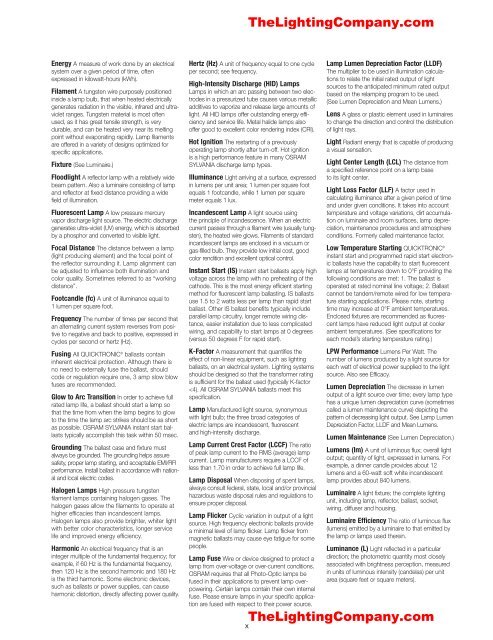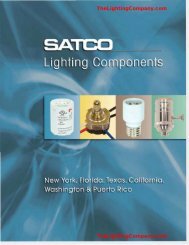Lamp and Ballast Catalog - The Lighting Company
Lamp and Ballast Catalog - The Lighting Company
Lamp and Ballast Catalog - The Lighting Company
- No tags were found...
You also want an ePaper? Increase the reach of your titles
YUMPU automatically turns print PDFs into web optimized ePapers that Google loves.
<strong>The</strong><strong>Lighting</strong><strong>Company</strong>.com<br />
Energy A measure of work done by an electrical<br />
system over a given period of time, often<br />
expressed in kilowatt-hours (kWh).<br />
Filament A tungsten wire purposely positioned<br />
inside a lamp bulb, that when heated electrically<br />
generates radiation in the visible, infrared <strong>and</strong> ultraviolet<br />
ranges. Tungsten material is most often<br />
used, as it has great tensile strength, is very<br />
durable, <strong>and</strong> can be heated very near its melting<br />
point without evaporating rapidly. <strong>Lamp</strong> filaments<br />
are offered in a variety of designs optimized for<br />
specific applications.<br />
Fixture (See Luminaire.)<br />
Floodlight A reflector lamp with a relatively wide<br />
beam pattern. Also a luminaire consisting of lamp<br />
<strong>and</strong> reflector at fixed distance providing a wide<br />
field of illumination.<br />
Fluorescent <strong>Lamp</strong> A low pressure mercury<br />
vapor discharge light source. <strong>The</strong> electric discharge<br />
generates ultra-violet (UV) energy, which is absorbed<br />
by a phosphor <strong>and</strong> converted to visible light.<br />
Focal Distance <strong>The</strong> distance between a lamp<br />
(light producing element) <strong>and</strong> the focal point of<br />
the reflector surrounding it. <strong>Lamp</strong> alignment can<br />
be adjusted to influence both illumination <strong>and</strong><br />
color quality. Sometimes referred to as “working<br />
distance”.<br />
Footc<strong>and</strong>le (fc) A unit of illuminance equal to<br />
1 lumen per square foot.<br />
Frequency <strong>The</strong> number of times per second that<br />
an alternating current system reverses from positive<br />
to negative <strong>and</strong> back to positive, expressed in<br />
cycles per second or hertz (Hz).<br />
Fusing All QUICKTRONIC ® ballasts contain<br />
inherent electrical protection. Although there is<br />
no need to externally fuse the ballast, should<br />
code or regulation require one, 3 amp slow blow<br />
fuses are recommended.<br />
Glow to Arc Transition In order to achieve full<br />
rated lamp life, a ballast should start a lamp so<br />
that the time from when the lamp begins to glow<br />
to the time the lamp arc strikes should be as short<br />
as possible. OSRAM SYLVANIA instant start ballasts<br />
typically accomplish this task within 50 msec.<br />
Grounding <strong>The</strong> ballast case <strong>and</strong> fixture must<br />
always be grounded. <strong>The</strong> grounding helps assure<br />
safety, proper lamp starting, <strong>and</strong> acceptable EMI/RFI<br />
performance. Install ballast in accordance with national<br />
<strong>and</strong> local electric codes.<br />
Halogen <strong>Lamp</strong>s High pressure tungsten<br />
filament lamps containing halogen gases. <strong>The</strong><br />
halogen gases allow the filaments to operate at<br />
higher efficacies than inc<strong>and</strong>escent lamps.<br />
Halogen lamps also provide brighter, whiter light<br />
with better color characteristics, longer service<br />
life <strong>and</strong> improved energy efficiency.<br />
Harmonic An electrical frequency that is an<br />
integer multiple of the fundamental frequency; for<br />
example, if 60 Hz is the fundamental frequency,<br />
then 120 Hz is the second harmonic <strong>and</strong> 180 Hz<br />
is the third harmonic. Some electronic devices,<br />
such as ballasts or power supplies, can cause<br />
harmonic distortion, directly affecting power quality.<br />
Hertz (Hz) A unit of frequency equal to one cycle<br />
per second; see frequency.<br />
High-Intensity Discharge (HID) <strong>Lamp</strong>s<br />
<strong>Lamp</strong>s in which an arc passing between two electrodes<br />
in a pressurized tube causes various metallic<br />
additives to vaporize <strong>and</strong> release large amounts of<br />
light. All HID lamps offer outst<strong>and</strong>ing energy efficiency<br />
<strong>and</strong> service life. Metal halide lamps also<br />
offer good to excellent color rendering index (CRI).<br />
Hot Ignition <strong>The</strong> restarting of a previously<br />
operating lamp shortly after turn-off. Hot ignition<br />
is a high performance feature in many OSRAM<br />
SYLVANIA discharge lamp types.<br />
Illuminance Light arriving at a surface, expressed<br />
in lumens per unit area; 1 lumen per square foot<br />
equals 1 footc<strong>and</strong>le, while 1 lumen per square<br />
meter equals 1 lux.<br />
Inc<strong>and</strong>escent <strong>Lamp</strong> A light source using<br />
the principle of inc<strong>and</strong>escence. When an electric<br />
current passes through a filament wire (usually tungsten),<br />
the heated wire glows. Filaments of st<strong>and</strong>ard<br />
inc<strong>and</strong>escent lamps are enclosed in a vacuum or<br />
gas-filled bulb. <strong>The</strong>y provide low initial cost, good<br />
color rendition <strong>and</strong> excellent optical control.<br />
Instant Start (IS) Instant start ballasts apply high<br />
voltage across the lamp with no preheating of the<br />
cathode. This is the most energy efficient starting<br />
method for fluorescent lamp ballasting. IS ballasts<br />
use 1.5 to 2 watts less per lamp than rapid start<br />
ballast. Other IS ballast benefits typically include<br />
parallel lamp circuitry, longer remote wiring distance,<br />
easier installation due to less complicated<br />
wiring, <strong>and</strong> capability to start lamps at 0 degrees<br />
(versus 50 degrees F for rapid start).<br />
K-Factor A measurement that quantifies the<br />
effect of non-linear equipment, such as lighting<br />
ballasts, on an electrical system. <strong>Lighting</strong> systems<br />
should be designed so that the transformer rating<br />
is sufficient for the ballast used (typically K-factor<br />




